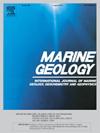Utilizing optical backscatter sensor and sediment traps for measuring sediment dynamics in low-energy marine environment
IF 2.2
3区 地球科学
Q2 GEOSCIENCES, MULTIDISCIPLINARY
引用次数: 0
Abstract
This study investigates the application of the SediMeter (SM) for assessing sedimentation and erosion in a low-energy basin, in conjunction with conventional sediment traps (STs) to characterize the vertical sediment profile in a marina at Port Dickson. Despite the widespread use of STs, a significant knowledge gap exists regarding their ability to capture dynamic sediment processes – such as rapid resuspension and short-term fluxes – which the SM is designed to monitor with high temporal resolution. Our results indicate that sediment fluxes in the water column do not directly correlate with water turbidity due to rapidly changing physical forcing conditions. Notably, the SM detected a pronounced layer of high-water-content sediment – attributed to a storm event followed by steady deposition of resuspended material after the event subsided. While the SM data revealed a clear relationship between semi-diurnal tides and variations in both turbidity and sediment flux, the ST recorded a consistent particle settling rate of 16.9 mg cm−2 day −1, underscoring a weak correlation between these two measurement techniques. This discrepancy suggests that the SM, which captures both sediment influx and resuspension in real time, cannot serve as a direct surrogate for the ST, which only quantifies net sediment accumulation. Instead, the SM provides high temporal resolution necessary for resolving transient sediment dynamics, whereas the ST offers an integrated assessment of overall sedimentation. Thus, the complementary use of both instruments is essential for addressing the current limitations in sediment monitoring and for achieving a comprehensive understanding of sediment transport processes in dynamic marine environments.

利用光学后向散射传感器和泥沙捕集器测量低能海洋环境下泥沙动态
本研究探讨了使用SediMeter (SM)来评估低能量盆地的沉积和侵蚀,并结合传统的沉积物捕集器(STs)来表征波德申码头的垂直沉积物剖面。尽管STs被广泛使用,但在它们捕捉动态沉积物过程(如快速再悬浮和短期通量)的能力方面存在着重大的知识差距,而SM旨在以高时间分辨率监测这些过程。我们的研究结果表明,由于快速变化的物理强迫条件,水柱中的沉积物通量与水浑浊度不直接相关。值得注意的是,SM探测到一个明显的高含水量沉积物层,这是由于风暴事件后再悬浮物质的稳定沉积造成的。虽然SM数据揭示了半日潮与浊度和沉积物通量变化之间的明确关系,但ST记录的颗粒沉降率一致为16.9 mg cm−2 day−1,强调了这两种测量技术之间的弱相关性。这种差异表明,实时捕获沉积物流入和再悬浮的SM不能直接替代仅量化净沉积物积累的ST。相反,SM提供了解决瞬态沉积动力学所需的高时间分辨率,而ST提供了整体沉积的综合评估。因此,这两种仪器的互补使用对于解决目前沉积物监测方面的局限性和全面了解动态海洋环境中的沉积物输送过程是必不可少的。
本文章由计算机程序翻译,如有差异,请以英文原文为准。
求助全文
约1分钟内获得全文
求助全文
来源期刊

Marine Geology
地学-地球科学综合
CiteScore
6.10
自引率
6.90%
发文量
175
审稿时长
21.9 weeks
期刊介绍:
Marine Geology is the premier international journal on marine geological processes in the broadest sense. We seek papers that are comprehensive, interdisciplinary and synthetic that will be lasting contributions to the field. Although most papers are based on regional studies, they must demonstrate new findings of international significance. We accept papers on subjects as diverse as seafloor hydrothermal systems, beach dynamics, early diagenesis, microbiological studies in sediments, palaeoclimate studies and geophysical studies of the seabed. We encourage papers that address emerging new fields, for example the influence of anthropogenic processes on coastal/marine geology and coastal/marine geoarchaeology. We insist that the papers are concerned with the marine realm and that they deal with geology: with rocks, sediments, and physical and chemical processes affecting them. Papers should address scientific hypotheses: highly descriptive data compilations or papers that deal only with marine management and risk assessment should be submitted to other journals. Papers on laboratory or modelling studies must demonstrate direct relevance to marine processes or deposits. The primary criteria for acceptance of papers is that the science is of high quality, novel, significant, and of broad international interest.
 求助内容:
求助内容: 应助结果提醒方式:
应助结果提醒方式:


